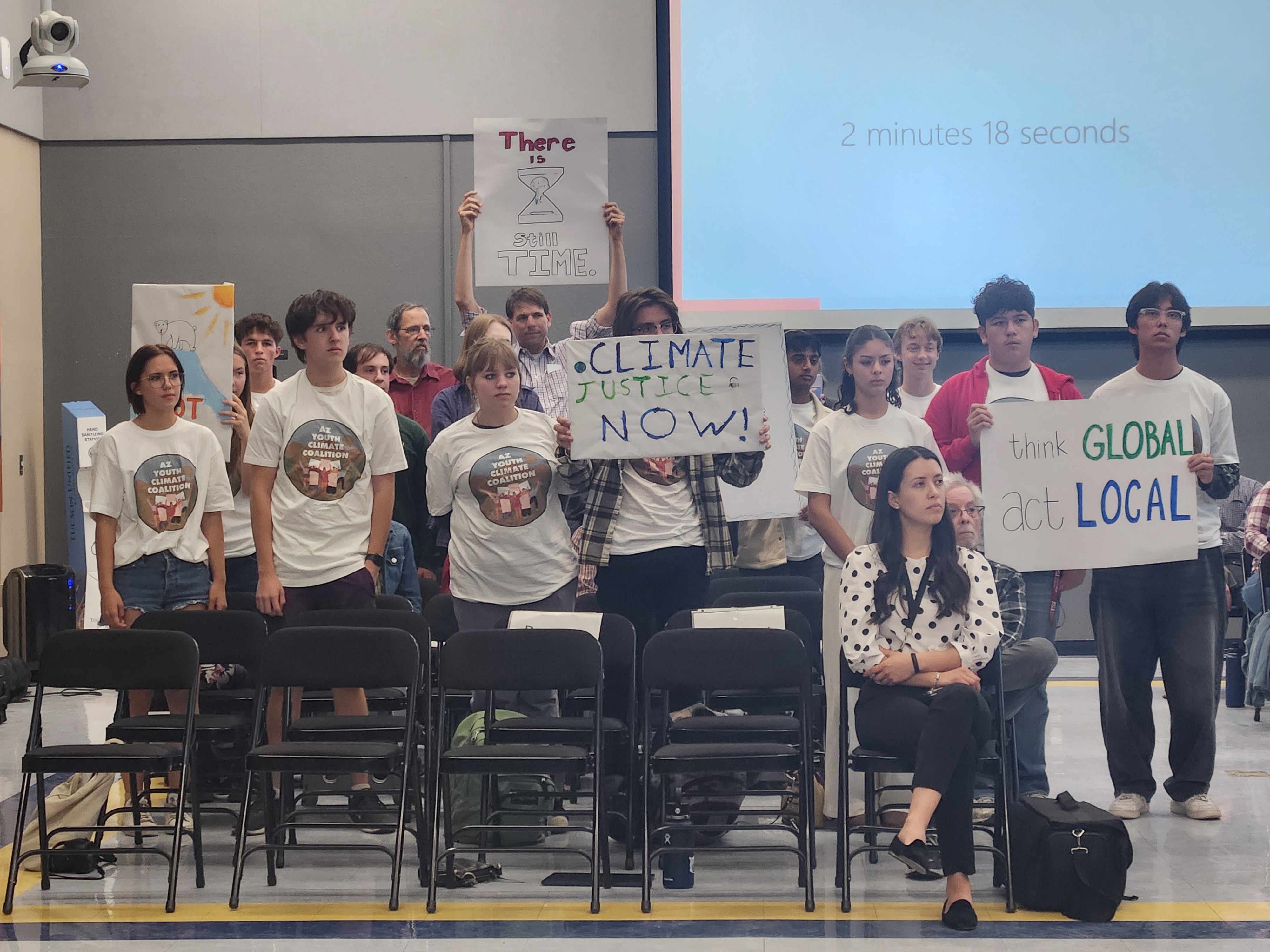 Arizona Youth Climate Coalition members at the Tucson Unified School District Governing Board meeting in Tucson, Ariz., on Tuesday, Oct. 29, 2024. Local students showed support for the passage of the TUSD Climate Resolution Act, which was researched, written and lobbied by students aged 13-20.
Arizona Youth Climate Coalition members at the Tucson Unified School District Governing Board meeting in Tucson, Ariz., on Tuesday, Oct. 29, 2024. Local students showed support for the passage of the TUSD Climate Resolution Act, which was researched, written and lobbied by students aged 13-20.
The Tucson Unified School District governing board passed a Climate Action Resolution Tuesday, with a 3-2 vote. It will strive to address the climate crisis and implement clean energy solutions throughout its schools.
The policy was written, researched and lobbied by local students aged 13-20.
Tina Cook, energy project manager for TUSD who collaborated with the students on the plan called it a framework to meet both short and long-term climate and sustainability goals.
“We’re going to mitigate the climate changes to reduce the carbon footprint and transition to more sustainable operations throughout the district, we want to adopt the climate change by proactively planning and building the resilience in preparation for climate impacts, all while we’re looking at the educational support for teaching and learning of the climate, the climate solution and the sustainability to prepare students to lead for a more sustainable future,” Cook said.
The plan includes electrifying TUSD’s bus fleet, striving towards energy efficiency, reducing solid waste, creating an extreme heat preparedness plan, and expanding climate education.
Cook said that the plan could save the district around $4.7 million per year if fully implemented.
Ojas Sanghi, a junior studying computer science at the University of Arizona is a co-lead of the Arizona Youth Climate Coalition (AZYCC), which helped create the framework.
“We’ve been working on this for 16 months,” Sanghi said. “To see all of the work that we’ve put into this finally come to fruition is really, really awesome and also kind of surreal.”
The district will next issue a Request for Proposals (RFP) to get a clearer picture of costs.
Dr. Gabriel Trujillo, superintendent of TUSD said an independent consultant will be needed for the policy, which is projected to span 30 years.
According to Sanghi, funding will partly come from TUSD Proposition 496, a $480 million bond approved by voters last November, which allocates funding towards school improvements like aging infrastructure, air conditioning, transportation, and technology.
Additional funds include grants from the Inflation Reduction Act (IRA).
Ravi Shah, a TUSD board member who worked with the AZYCC, highlighted that the district recently bought 10 electric vehicles and charging infrastructure, using IRA grants and funds from Tucson Electric Power.
“Having these electric vehicles will be saving money annually on fuel costs and other costs on running these diesel vehicles, let alone reducing our climate footprint and these are things that we weren’t factoring in when we were looking at initial costs,” Shah said.
Shah voted yes on the passage of the policy.
Board member Sadie Shaw, who voted no, raised concerns about the district’s $16 million deficit and questioned the plan’s estimated $900 million total cost.
“I do have some hesitations on some aspects of this policy, just because we’re a school district and our main focus should be in educating students,” Shaw said.
Cook clarified that the cost includes bond funding and a range of projects.
Shah emphasized that the resolution provides a gradual framework for changes rather than an immediate overhaul.
“We approved over a dozen HVAC systems just this past year as part of our bond funding– every single one of those upgrades are energy efficient,” Shah said. “So while we’re spending the [bond] money on the capital [improvements] we’re going to reap the benefits on our lower maintenance and operations budget in terms of utility and other fuel costs for the next generation because the equipment that we have purchased will be able to be used for the next 10, 20 plus years.”
The plan sets a net zero emissions target for 2040 and aims to reduce emissions and energy usage by 2035.
Indirect goals include reducing vehicle idling on campuses and single-use plastics, prioritizing local and sustainable food, implementing composting, and incentivizing walking, biking, and public transit.
The plan also includes designating cooling centers, improving water efficiency and establishing battery backups for power outages.
The district will also integrate climate workforce development programs.
TUSD also plans to track progress on a public dashboard and assess the social costs of greenhouse gasses while prohibiting carbon credits for emissions offsets.
Read the full TUSD Climate Action Plan here.

By submitting your comments, you hereby give AZPM the right to post your comments and potentially use them in any other form of media operated by this institution.